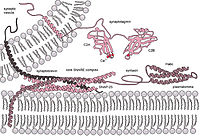
Photo from wikipedia
This book has a very ambitious goal of providing an up-todate review of a wide range of biologics used as therapeutic agents and it is clearly stated that there are… Click to show full abstract
This book has a very ambitious goal of providing an up-todate review of a wide range of biologics used as therapeutic agents and it is clearly stated that there are many new biologics being developed that will be approved for clinical use in the near future. However, there is so much information brought together in this 610-page book that it will be a useful reference for many years. The book has an interesting structure in that each chapter has a brief introduction to the biology and chemistry of the biologic being discussed, followed by an in-depth description of the activity and adverse effects of each approved biologic of a particular class, which is then followed by quite an extensive summary of the preceding chapter. Much of the information provided in the body of the chapter is repeated in these summaries. At first I found this repetition annoying, but as I read the book over an extended period it became evident that the summaries made it easy to go back and find specific information without having to skim the whole chapter. As a general comment, the tables of information in each chapter are excellent and, again, an easy way to quickly find whether a specific biologic is included in the book. The colour diagrams throughout the book are clear and informative. The book is divided into 13 chapters, with the first chapter defining biologics and adverse reactions and the approval processes for biologics. Chapters 2–4 deal with monoclonal antibodies (MAbs), with Chapter 2 providing a mini-review of MAb structure, function and production. Table 2.1 provides a list of therapeutic MAbs currently marketed with regulatory approval from the US Food and Drug Administration (FDA) or European Medicines Agency (EMA) as of June 2016, giving the trade name, type of MAb, cell line used for production, target, mechanism of action and approved indications. Chapter 3 deals with approved MAbs for cancer therapy, and again includes a table listing all of the approved MAbs with their target, warnings, precautions, risks, safety concerns and other adverse events. Chapter 4 discusses MAbs approved for non-cancer therapy. The following chapters each deal with the other classes of biologics. In the chapter on cytokines (Chapter 5), the author makes the comment that although the book concentrates on adverse effects, the reader is reminded that this should not negate the clear clinical improvements each of these biologics can bring. In Chapter 6, three types of fusion proteins are described: Fc fusion proteins, human albumin fusion proteins and an interleukin (IL)-2/diphtheria toxin recombinant fusion protein. Eleven peptide hormones are discussed in Chapter 7, starting with a description of the structure and mechanism of action of each hormone, followed by a detailed description of each therapeutic and their adverse effects and, in many cases, the treatments used to manage those adverse effects. Chapters 8–12 deal with glycoprotein hormones, enzymes approved for therapy, blood coagulation factors, vaccines and botulinum neurotoxins. Again, each chapter gives a background to each product and their usage, followed by a detailed discussion of their adverse effects. & Kevin Broady [email protected]
Journal Title: Drug Safety
Year Published: 2017
Link to full text (if available)
Share on Social Media: Sign Up to like & get
recommendations!